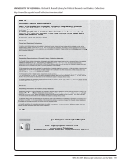100 · Survey Results: Survey Questions and Responses
Increased usage. We have nearly tripled
our use since we began adding our
EAD-encoded finding aids to the Web.
Researchers (especially those who
are not “professional” researchers)
are better able to find us and our
collections.
Ease in working with undergraduates.
We have had great success in bringing
undergraduates into Special Collections,
due in part to the finding aids and
digitized materials on our Web site.
Collaboration. Bringing manuscript
collections online means that they are
easier to find outside of the walls of the
repository. We can more readily locate
institutions with collections similar to
ours (and vice versa). This opens the
door to potential collaborative efforts to
bring together finding aids and digital
images. Because our metadata is in a
shareable, standard format, we could
more easily participate in such an effort.
Increased use of collections. Increased access to collection
information helps users and staff.
Increased visibility and awareness
of collections. This can lead to
development opportunities and can
attract more collections.
Increased user access to manuscript
collections. Manuscript collections that
are available online provide users with
24/7 access to collection information.
Individuals unable to visit the repository
can view collection information online
at their convenience and submit
reference/reproduction requests via
the Web or by telephone. This allows
a repository to expand its user-base
exponentially.
Increased usage of manuscript
collections onsite. Disseminating
collection information online is a good
way to increase visibility and leads
to repository visits by researchers,
scholars, and interested parties who
need to obtain a more in-depth
understanding of a specific collection’s
contents.
The opportunity to take advantage
of Web 2.0 technologies. By having
manuscript collections online,
repositories have the option to employ
the use of new technologies that allow
for a more collaborative approach to
finding aid creation.
Increased visibility and ease of
information access for researchers.
Increased visibility of collections and
therefore increased collection use.
Easier for staff to access collection
descriptions in one place.
Can provide information more easily
to patrons when answering reference
questions that include information in
the finding aids.
Increased visibility to potential users. Common location for information about
manuscripts and archival collections
available anywhere there is network
access.
Less wear and tear on the originals
along with improved retrieval.
Increased visibility/accessibility by staff
and users.
Ability to collocate similar and related
resources across institutions.
Ability to integrate more detailed
metadata in other access tools (online
catalogs, institutional repositories, etc.)
Increased usage. We have nearly tripled
our use since we began adding our
EAD-encoded finding aids to the Web.
Researchers (especially those who
are not “professional” researchers)
are better able to find us and our
collections.
Ease in working with undergraduates.
We have had great success in bringing
undergraduates into Special Collections,
due in part to the finding aids and
digitized materials on our Web site.
Collaboration. Bringing manuscript
collections online means that they are
easier to find outside of the walls of the
repository. We can more readily locate
institutions with collections similar to
ours (and vice versa). This opens the
door to potential collaborative efforts to
bring together finding aids and digital
images. Because our metadata is in a
shareable, standard format, we could
more easily participate in such an effort.
Increased use of collections. Increased access to collection
information helps users and staff.
Increased visibility and awareness
of collections. This can lead to
development opportunities and can
attract more collections.
Increased user access to manuscript
collections. Manuscript collections that
are available online provide users with
24/7 access to collection information.
Individuals unable to visit the repository
can view collection information online
at their convenience and submit
reference/reproduction requests via
the Web or by telephone. This allows
a repository to expand its user-base
exponentially.
Increased usage of manuscript
collections onsite. Disseminating
collection information online is a good
way to increase visibility and leads
to repository visits by researchers,
scholars, and interested parties who
need to obtain a more in-depth
understanding of a specific collection’s
contents.
The opportunity to take advantage
of Web 2.0 technologies. By having
manuscript collections online,
repositories have the option to employ
the use of new technologies that allow
for a more collaborative approach to
finding aid creation.
Increased visibility and ease of
information access for researchers.
Increased visibility of collections and
therefore increased collection use.
Easier for staff to access collection
descriptions in one place.
Can provide information more easily
to patrons when answering reference
questions that include information in
the finding aids.
Increased visibility to potential users. Common location for information about
manuscripts and archival collections
available anywhere there is network
access.
Less wear and tear on the originals
along with improved retrieval.
Increased visibility/accessibility by staff
and users.
Ability to collocate similar and related
resources across institutions.
Ability to integrate more detailed
metadata in other access tools (online
catalogs, institutional repositories, etc.)








































































































































































































